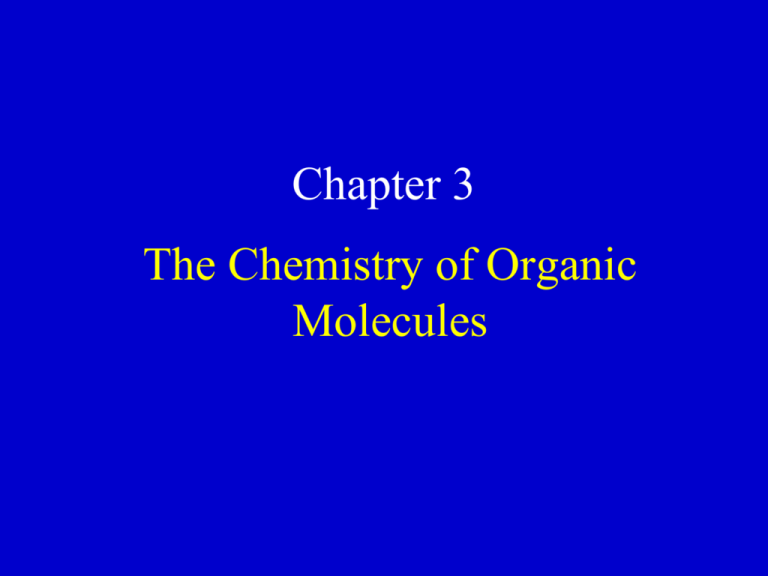Organic Macromolecules Lecture
advertisement

Chapter 3 The Chemistry of Organic Molecules Figure 4.3 Valences for the major elements of organic molecules Why Carbon? • Most versatile building blocks of molecules – Tetravalence – Can link together – Covalent compatibility with variety of elements • Variation in carbon skeletons contributes to the diversity of organic molecules – Hydrocarbons – Isomers – shape can dramatically alter activity Figure 4.4 Variations in carbon skeletons Figure 4.2 The shapes of three simple organic molecules Figure 4.6 Three types of isomers Figure 4.6ax Structural isomers Figure 4.7 The pharmacological importance of enantiomers Functional Groups • A specific configuration of atoms commonly attached to C-skeletons, usually involved in chemical reactions • Behave consistently from one organic molecule to the next • Contribute to distinctive properties of organic molecules • Most molecules have two or more Table 4.1 Functional Groups of Organic Compounds Functional Groups cont. • Hydroxyl – Alcohols – Polar – Increase solubility • Carbonyl Functional Groups cont. • Carboxyl – Carboxylic acids – Very polar • Amino – Amines – Basic Functional Groups Cont. • Sulfhydryl – Thiols – Can interact to help stabilize structures • Phosphate – One fxn includes energy transfer Recap • Emergent properties of organic compounds due to: – Arrangement of carbon skeleton – Functional groups added to skeleton • Variation at molecular level underlies biological diversity Macromolecules • Large biological molecules formed from small organic molecules • Polymers…made up of monomers • Synthesized by cells…how? Figure 5.2 The synthesis and breakdown of polymers Carbohydrates • • • • Sugars End in -ose CH2O Carbonyl group and multiple hydroxyl groups • Monosaccharides and disaccharides = fuel and carbon sources Figure 5.3 The structure and classification of some monosaccharides Figure 5.3x Hexose sugars Glucose Galactose Figure 5.4 Linear and ring forms of glucose Figure 5.5 Examples of disaccharide synthesis Figure 5.5x Glucose monomer and disaccharides Glucose monomer Sucrose Maltose Polysaccharides • thousands of monosaccharides • Storage and structural roles • Glycogen, starch, cellulose, peptidoglycan (sugars + amino acids), and chitin (contains nitrogen) Figure 5.7a Starch and cellulose structures Figure 5.7b,c Starch and cellulose structures Figure 5.7x Starch and cellulose molecular models Glucose Glucose Cellulose Starch Figure 5.6 Storage polysaccharides Figure 5.8 The arrangement of cellulose in plant cell walls Figure 5.x1 Cellulose digestion: termite and Trichonympha Figure 5.x2 Cellulose digestion: cow Chitin Figure 5.9 Chitin, a structural polysaccharide: exoskeleton and surgical thread Peptidoglycan Lipids • • • • Diverse group of nonpolymers Share one trait: hydrophobic Consist mainly of hydrocarbons Fats, phospholipids, waxes, steroids Fats • Glycerol + fatty acids • Fatty acids: carbon chain with carboxyl group at end • Triglycerols • Saturated vs unsaturated Figure 5.11 Examples of saturated and unsaturated fats and fatty acids Fats cont. • Functions: – Energy (2x a polysaccharide) – Storage – adipose tissue – swells and shrinks – Cushions – Warmth Artherosclerosis Phospholipids • Glycerol + 2 fatty acids + phosphate group • Amphipathic • Major components of cell membranes Figure 5.12 The structure of a phospholipid Figure 5.13 Two structures formed by self-assembly of phospholipids in aqueous environments Steroids • Carbon skeletons consisting of four fused rings • Hormones (many produced from cholesterol) • Vary in their functional groups Figure 4.8 A comparison of functional groups of female (estradiol) and male (testosterone) sex hormones Waxes • Protectant • Water-proofing • Corrosion prevention Proteins • • • • Greek: “first place” 50% + of dry weight of most cells Instrumental in activities Structural support, storage, transport, signaling within organism, movement of organism, defense against foreign substances, enzymes (help regulate metabolism) Proteins cont. • Vary extensively in structure • Unique 3d shape • Polymers of amino acids: polypeptides Figure 5.15 The 20 amino acids of proteins: nonpolar Figure 5.15 The 20 amino acids of proteins: polar and electrically charged Peptide Bonds Proteins cont. • A functional protein consists of 1+ polypeptides precisely twisted, folded, and coiled into a precise 3d conformation • Globular vs fibrous • Function depends on ability to recognize and bind to some other molecule • Determined by amino acid sequence Figure 5.18 The primary structure of a protein Figure 5.20 The secondary structure of a protein Figure 5.22 Examples of interactions contributing to the tertiary structure of a protein Figure 5.23 The quaternary structure of proteins Figure 5.24 Review: the four levels of protein structure Figure 5.17 Conformation of a protein, the enzyme lysozyme Figure 5.19 A single amino acid substitution in a protein causes sickle-cell disease Fibrous vs globular Figure 5.21 Spider silk: a structural protein What determines protein conformation? • • • • • Amino acid sequence pH Salt concentration Temperature Chaperonins – protein molecules that assist the proper folding other proteins; keep it away from “bad influences” • If environment is changed or altered from “native” conditions = denatured Figure 5.25 Denaturation and renaturation of a protein Figure 5.27 X-ray crystallography Table 5.1 An Overview of Protein Functions Nucleic Acids • DNA and RNA • Genetic material • DNA directs the synthesis of RNA, which then directs the ribosomes to make proteins • Polymers of nucleotides Figure 5.29 The components of nucleic acids Figure 5.x3 James Watson and Francis Crick Figure 5.x4 Rosalind Franklin Erwin Chargaff 3’ and 5’ ends Genetic Material Figure 5.30 The DNA double helix and its replication DNA and proteins as tape measures of evolution • Two species that are more closely related share a greater proportion of their DNA and protein sequences than do distantly related species ATP • RNA nucleotide + • 2 more P groups • Energy transfer!









